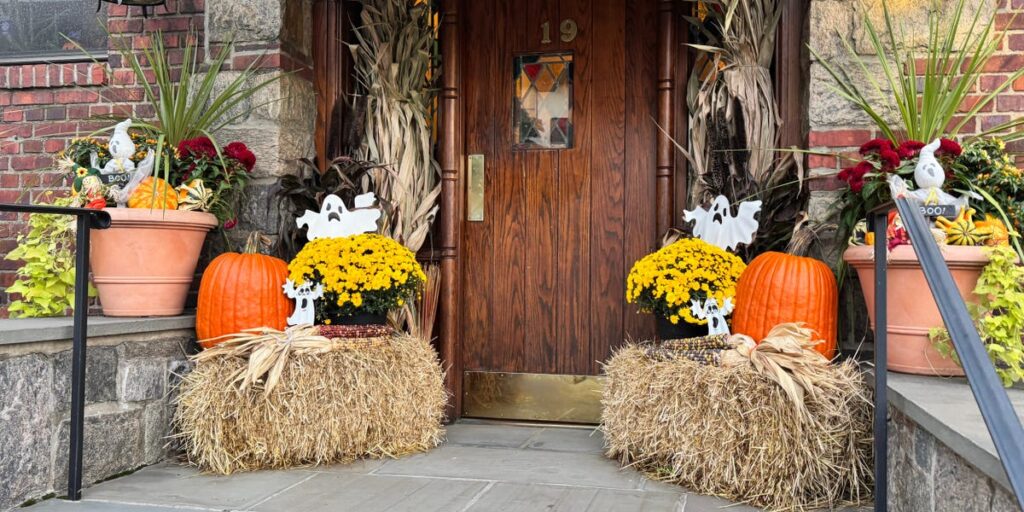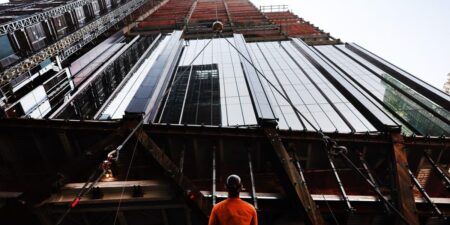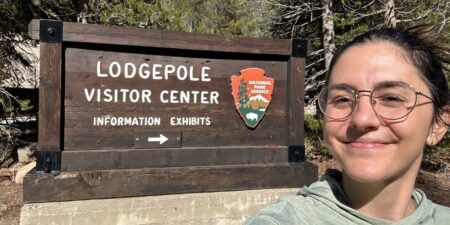X
Bluesky
Copy link
Impact Link
Save
Saved
Read in app
subscribers. Become an Insider
and start reading now.
Have an account? .
- I visited Sleepy Hollow, a village around 30 miles outside New York City.
- It was immortalized in “The Legend of Sleepy Hollow,” the story of the Headless Horseman.
- Sleepy Hollow and the adjacent areas go all out for Halloween, without the kitsch of Salem.
Halloween is just around the corner, and if you’re looking to visit a place with spooky history, fun activities, and plenty of pumpkin beer, there’s a village in the Northeast that should be at the top of your list.
No, it’s not Salem, the Halloween capital of the US. It’s Sleepy Hollow, a village that’s a 40-minute train ride from New York City.
You might recognize Sleepy Hollow’s name from the Fox series of the same name, the 1999 film starring Johnny Depp and Christina Ricci, the 1949 Disney film “The Adventures of Ichabod and Mr. Toad,” or the original 1820 short story by Washington Irving, “The Legend of Sleepy Hollow.”
But did you know it’s a real place? A real place that goes completely all out for Halloween every fall?
I took a trip to Sleepy Hollow on a beautiful fall day to see what it has to offer, and to see if it’s time for the village to be in the same conversation as Salem.
Here’s what it was like.
Sleepy Hollow was settled in the 1600s by Dutch immigrants, though various Native American tribes first called the land home.
According to Sleepy Hollow’s website, the Weckquaesgeck Indians were the first people in the area, and have been described as “a Delaware Tribe or a Mohican Tribe, or perhaps some mix of the two.”
It was first called “Slapershaven” (Sleepers’ Haven in English) in 1655 by a Dutch colonist.
In the years since, many famous figures have called Sleepy Hollow home — though, for many years, it wasn’t called Sleepy Hollow at all.
In the late 1800s, Sleepy Hollow was actually renamed North Tarrytown, as the neighboring village, Tarrytown, was becoming an economic center due to a General Motors plant during the Industrial Revolution.
But when the plant closed down, the area suffered economically — the closure led to the loss of 4,000 jobs and a major loss in tax revenue.
To capitalize on the cultural caché of Sleepy Hollow, the town voted to rename North Tarrytown in 1996 in hopes of boosting tourism.
“Everything is all about the Headless Horseman now,” Sleepy Hollow village administrator Anthony Giaccio told Business Insider in 2014.
My first stop was the Sleepy Hollow Cemetery, which was immortalized in “The Legend of Sleepy Hollow.”
In the story, the Headless Horseman rides through the cemetery at night, terrorizing the town’s residents, including Ichabod Crane.
Tours are given throughout the day, including ghost tours at night, but you can also wander around at your own leisure.
It’s free to enter the cemetery and walk around yourself, but the tours range from $30 to $60, depending on the type of tour. Those in the daytime are cheaper, while the lantern and “Murder and Mayhem” nighttime tours are more expensive.
Washington Irving, the author of “The Legend of Sleepy Hollow” and “Rip Van Winkle,” is buried here.
Irving died in 1859. While he himself never had any children — his fiancée died when she was just 17 and he never married — he’s surrounded by many generations of family members.
Irving’s gravestone is marked with American flags, as he served in the War of 1812 and was the US ambassador to Spain from 1842 to 1846.
Famous Gilded Age figures are also buried here, such as Andrew Carnegie.
At one point, Carnegie was the richest man in America after selling his company, Carnegie Steel, in 1901, to J.P. Morgan.
His wife, Louise Whitfield Carnegie, is buried beside him.
His gravestone is covered in coins.
Per the Carnegie Medal of Philanthropy, people leave coins for good fortune.
The Rockefeller family has a giant mausoleum in the cemetery, mainly dedicated to William Rockefeller Jr.
William Rockefeller Jr., along with his brother John D. Rockefeller, cofounded Standard Oil, earning the Rockefellers their fortune during the Gilded Age.
He died in 1922 with a net worth significantly lower than his brother’s, who was the world’s first billionaire, due to taxes and debts.
Many Rockefellers are buried here (though not John D.), including Nelson Rockefeller, the governor of New York from 1959 to 1973, and the vice president under Gerald Ford from 1974 to 1977.
A Rockefeller family mansion, Kykuit, is also located near Sleepy Hollow and is open to tours.
Kykuit was the retirement home of William’s elder brother, John. He spent much of the last 40 years of his life there. Tours start at $25.
Washington Irving’s home, Sunnyside, is located about 5 miles south of Sleepy Hollow, in Irvington. It’s also open to the public.
Irving built the house in 1835. Historic Hudson Valley offers tours of Sunnyside for $20.
But back to the cemetery: It’s not a tourist trap by any means, but it is a beautiful way to spend a fall afternoon … or a spooky night.
The cemetery is 90 acres with about 47,000 interments, according to its website.
Other famous people buried here include Elizabeth Arden, cinematographer Floyd Crosby, and members of prominent New York families such as the Astors, the Hamiltons, and the Chryslers.
You’re never far from the Headless Horseman.
The legend goes that the Headless Horseman rides around looking for his missing head every night.
After that, I walked around the village of Sleepy Hollow. I clocked the Halloween-appropriate orange street signs immediately.
In the village of Sleepy Hollow, which has around 10,000 residents, I saw flags and banners celebrating Halloween.
Almost every shop window I passed was decorated for Halloween.
This was outside a pizza parlor.
There was also a photo op for anyone who wanted to be the Horseman themselves.
I wasn’t ready to be turned into a jack-o’-lantern quite yet.
A local bookstore had plenty of reading materials for anyone interested in learning more.
There’s plenty of literature about Sleepy Hollow, and different versions of the classic short story.
I popped into a local coffeeshop, which, of course, was counting down until Halloween.
This was at Sleepy Coffee Too, a nonprofit business dedicated to hiring people with disabilities. It has plenty of seasonal drinks for the fall.
As I walked around, I appreciated the amount of outdoor public spaces.
I would imagine that on a weekend in October, this would be packed.
There was also a helpful map pointing out all the sites.
For any history buff, there are many sites to see in the Sleepy Hollow area, including the ruins of another Rockefeller mansion, an old aqueduct, and the Tarrytown Lighthouse.
One of my favorite stores was Cozy Coven.
This is Cozy Coven’s first year in Sleepy Hollow, and the witchy vibes of the store are quite appropriate.
It was filled with souvenirs, candles, crystals, incense, and more.
Historic Sleepy Hollow is only a few blocks away, but Tarrytown, the town just south of it, also has lots to offer Halloween fans.
Of course, since I didn’t go on a weekend, there were some Sleepy Hollow events I missed.
They included the Twilight Village at Philipsburg Manor, an estate dating back to the 1600s, which features storytellers, fire performers, food trucks, and local artisans; a “gothic market” at Lyndhurst; a Halloween 10K; a Halloween parade; a live performance of some of Edgar Allen Poe’s best works; and more.
I ate at Horsefeathers, which was completely decked out for Halloween.
There were so many lights, and classic horror films played on a TV in the corner.
I couldn’t escape the Headless Horseman.
There was a mural on the other side of the restaurant showing some of the most famous authors, like Irving and Poe.
After dinner and a delicious cider-doughnut-flavored hard cider, I explored Tarrytown.
There were many window displays like this.
A map of Tarrytown quoted Irving describing himself as a “ready believer in relics, legends, and local anecdotes of goblins and great men.”
“What is it to us whether these stories be true or false, so long as we can persuade ourselves into the belief of them and enjoy all the charm of the reality,” he continued.
There were plenty of small businesses to support and beautiful architecture to see.
I felt like I was walking around the set of “Practical Magic.”
Tarrytown and Sleepy Hollow are right on the Hudson River, so the views were unbelievable.
It is quite steep, though.
As the sun set, it was time for my final activity of the day: The Great Jack O’Lantern Blaze in Croton-on-Hudson, 9 miles north of Tarrytown.
It’s held every year at Van Cortlandt Manor, a 17th-century estate.
At $50 a ticket, it’s not cheap, but I could tell immediately why it was a bit steep.
There was a gift shop, a café, a bar, and plenty of photo ops.
The event features more than 7,000 hand-carved pumpkins.
I could share 100 photos of the incredible displays, but I’ll stick to a few of the most impressive.
This one was modeled on the Tarrytown Lighthouse.
A personal favorite was the tunnel meant to resemble the night sky.
It was a long tunnel completely filled with illuminated pumpkins.
In time for “Wicked: For Good,” there was a yellow brick road, Emerald City, Glinda, and the Wizard of Oz.
The pumpkin-Glinda even resembled Ariana Grande.
I was also impressed by the pumpkin Statue of Liberty.
It towered over everyone.
This circus train was unbelievable.
Every car had a different pumpkin animal carved into it.
Of course, the final sight to see was my new best friend, the Headless Horseman.
There were pumpkin headstones carved with Irving’s name, among other names.
I can’t recommend Sleepy Hollow enough for anyone looking to get into the Halloween spirit.
I found that Sleepy Hollow has the perfect amount to do on a day trip.
And while it might not be as large or have as many tourist activities as Salem, it did mean the village wasn’t completely overtaken by tourists during my weekday visit.
So, I recommend you take advantage of spooky season while you can and visit the land of Ichabod Crane.
Read the full article here
















